New York, also known as ‘The Empire State’, might not be the first place that you think of when it comes to birding, but it has a number of farms, rivers, mountains, and forests that do indeed provide homes for a number of lovely birds to be found in. Today we are going to explore the popular backyard birds of New York and give some tips on what they like to eat, where they like to hide, and share some hotpots and feeder tips which can help you to lure and spot these elusive winged wonders. Let’s talk about the birds of New York!
3 Categories – 200 Birds
New York is home to approximately 200 species of birds and they are out there waiting to be spotted provided that you know where and WHEN to look. We’re going to give you the ‘when’ first by dividing up our listed birds in the following fashion:
- Year-round Resident birds
- Birds of Spring, Summer, and Early Fall
- Fall and Winter Birds
We’ll let you know how to identify them, where to look, and what kind of foods to put in the feeder to match their diets as closely as you can. The rest is going to be up to those shy, beautiful birds, though, so be sure to practice a little patience. Good things come to those who wait!
New York ’s Year-round Resident birds
The birds in this section make New York their home year-round and who could blame them? The food is great and the scenery is nice and let’s face it, there’s nowhere on the planet exactly like it. Look for these native New Yorkers this year when you are out and about:
- Tufted Titmouse
- Northern Cardinal
- Black-capped Chickadee
- Mourning Dove
- Dark-eyed Junco
Tufted Titmouse – Baeolophus bicolor
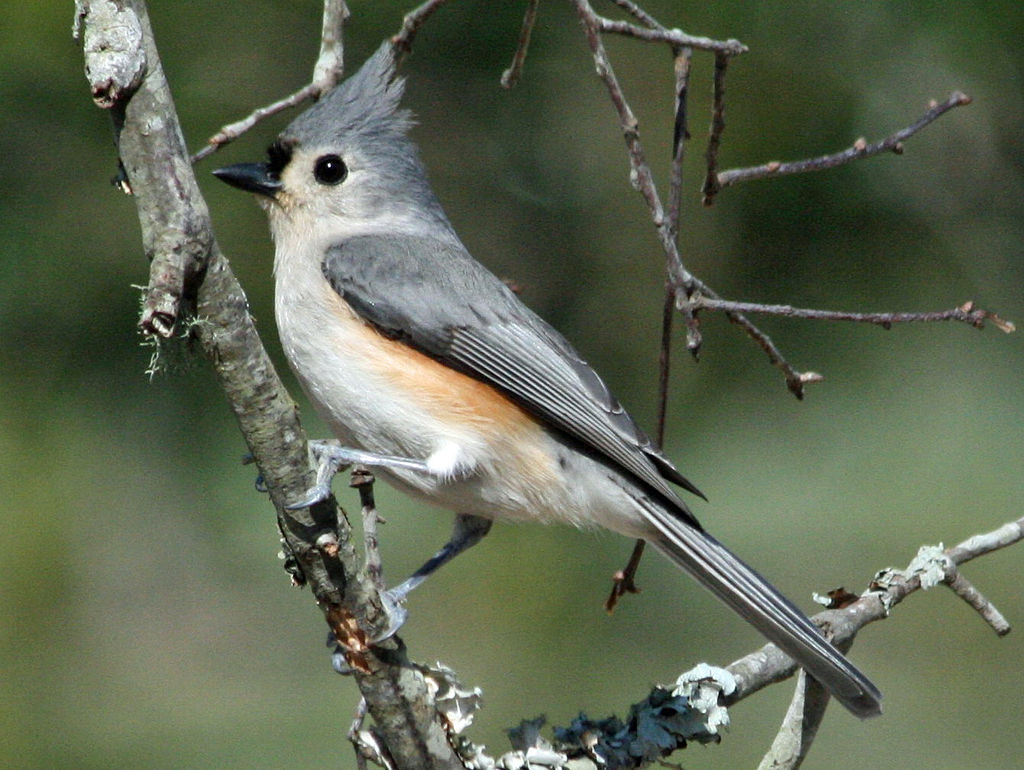
Coloration and Markings: The Tufted Titmouse has velvety gray color on its back and medium length, blue-gray wings to go with their long, gray tails. They have a white breast and underbelly with some orange-yellow wash displaying just under the wings and facially, these birds have mostly white faces, with the white coming up to the cheek level and circling the eyes. The back of the head and the top, however, are gray-blue, and this bird has a lovely little crest. You will also notice a large, black spot above a short, stocky black bill.
Size: These birds measure in at 5.5 – 6.3 inches in length and have wingspans of 7.9 to 10.2 inches.
Habitat: Tufted Titmice favor deciduous and Evergreen woods, though they often range out into parks, home gardens, orchards, and backyards.
Diet: These birds will eat suet, Black Oil Sunflower seeds, Nyjer thistle, and crunchy peanut butter if you’ve got it! Try one or more of these s a base and experiment, as these little guys like a variety of foods.
Northern Cardinal – Cardinalis cardinalis
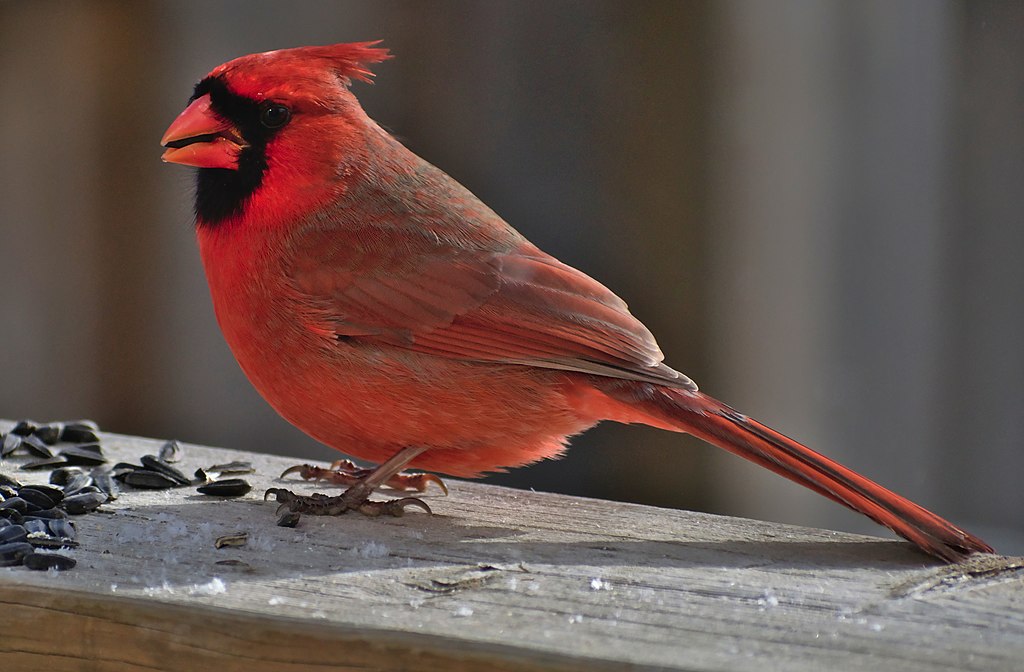
Coloration and Markings: Northern Cardinals are beautiful and catching a glimpse of these birds has inspired many to take up birding. The males and females are easy to identify, with the males being completely red, with long wings and tails and a deeper red coloartion present on their faces. You will also see a distinctive black mask that covers the eyes and travels down to triangulate under the large, conical orange (or red-orange) bill. Males may display a little gray when molting but otherwise just look for that distinctive crimson, it’s hard to miss. Female Cardinals are a soft brown that is no less striking, and you will see tinges of red throughout the plumage as well.
Size: These birds measure in at 8.3 – 9.1 inches and have wingspans of 9.8 to 12.2 inches.
Habitat: Cardinals love open areas with a little bit of dense cover, so look for them here in areas where you see trees and shrubs, bushes, or brambles nearby. When not in the woods, these birds aren’t shy about people and you can see them all over the city. Watch for them on fences, phone lines, or simply in your own backyard checking out the feeder.
Diet: Safflower and Black Oil Sunflower seeds are popular with this bird and other favorites include cracked corn, peanuts, and chopped cherries.
Black-capped Chickadee – Poecile atricapillus
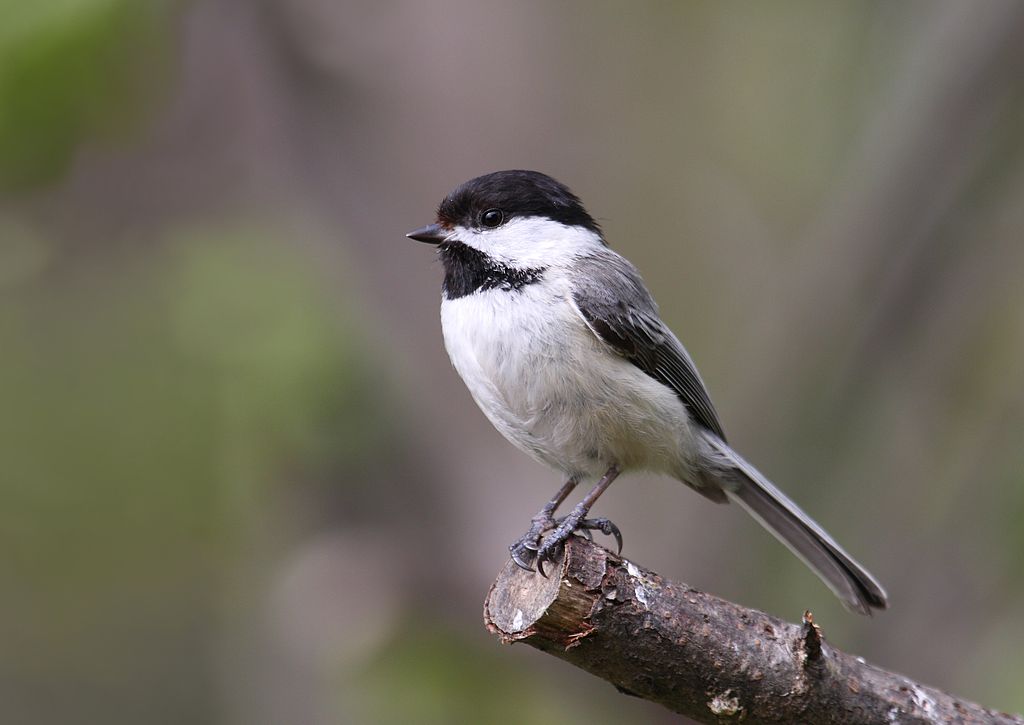
Coloration and Markings: Black-capped Chickadees has velvety gray backs, with medium-length gray wings that sho white edging throughout, and long, gray tails which are white on the edges. They have a white breast and underbelly and facially, The center of their faces are white bordered by the black bib under the bird’s bill and the large, black cap above which terminates at just under mid-eye level. These birds have tiny, conical back bills.
Size: These little beauties measure 4.7 – 5.9 inches from head to tail and have wingspans of 6.3 to 8.3 inches.
Habitat: Chickadees just need trees and a little cover in the form of brush, brambles, thorns, or bushes. They also like water so you can sometimes spot them next to ponds or in marshes when there is some cover to be found and they often range out into parks and welcoming backyards with well-stocked feeders.
Diet: Chunky peanut butter, suet, and Black Oil Sunflower seeds are 3 favorites of the Black-capped Chickadee that can attract them and keep them coming back for more.
Mourning Dove – Zenaida macroura
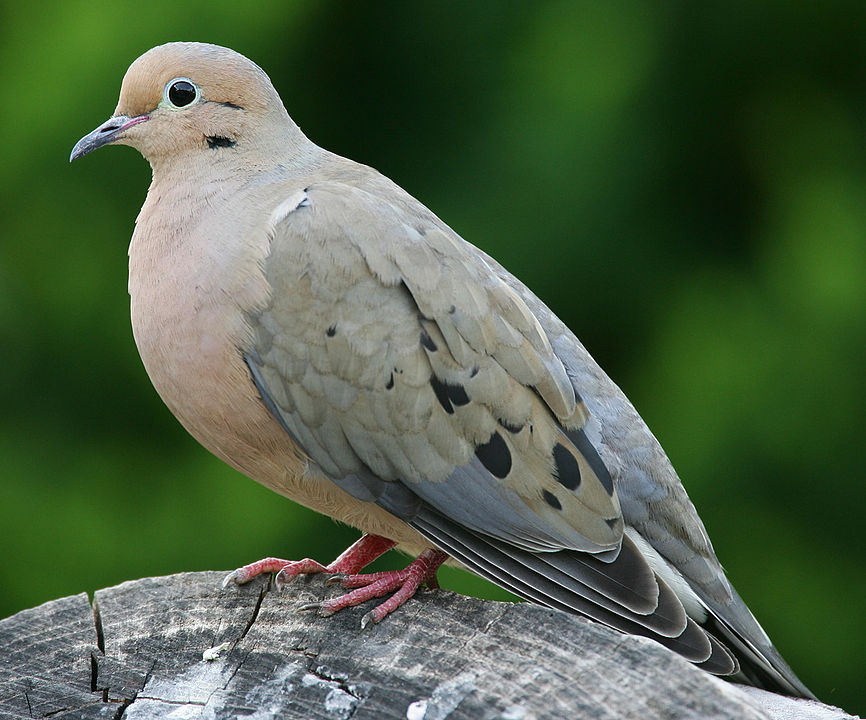
Coloration and Markings: Mourning Doves have gray or brown backs with large, gray wings which bear a heavy tan coloration and distinct black spotting towards the center. They have long, gray tails and their breast and underbelly are white with a saturation of tan throughout. Facially, this bird displays the most concentrated tan color and this Dove has a medium length, straight black bill.
Size: Roughly Robin-sized, these birds measure in at 9.1 – 13.4 inches from tip to tail and have wingspans of approximately 17.7 inches in width.
Habitat: Rather than the woods, looks for these birds in parks and overgrown fields, or simply just about anywhere around town. These birds aren’t very shy as long as there is a little cover nearby and can often be seen on the sidewalk or scoping you out from a nearby fence.
Diet: Cracked corn, White Proso millet, or a simple mix of wheat and oats can make Mourning Doves into Happy Doves when it comes to feeder fare.
Dark-eyed Junco – Junco hyemalis

Coloration and Markings: With over 16 regional variations of the Dark-eyed Junco we have decided to go with the most common coloration that you are likely to see. Juncos have dark gray or brown backs, with medium-length wings of the same coloration and long, gray tails which are white on the undersides. The rump of this bird is white and begining at the underbelly you will see white with a dark brown or gray flanking, which grows larger as the color approaches breast. White will be mostly at the center or the breast with the gray and brown flanking heavily and when the bird it at rest this gives the effect of the lower portion of the bird being white and the upper 23 being dark brown or gray. Facially, this bird has a stout, conical pink bill and the face will match the brown or gray color of the rest of the upper body.
Size: These birds measure in at 5.5 – 6.3 inches in length with wingspans of 7.1 to 9.8 inches.
Habitat: In the warmer months these birds prefer coniferous or mixed coniferous woods, ranging out with the most frequency in winter. Then they are regulars at local parks, golf courses, fields, and backyards. Leave a little something out for them to show that they are welcome and you might earn yourself a closer look at the lovely Dark-eyed Junco.
Diet: These birds love Black Oil Sunflower seeds, cracked corn, and White Proso millet so be sure to leave one or all of these out if you are looking to get this bird’s attention.
New York’s Birds of Spring, Summer, and Early Fall
When the Daffodils start showing and the Magnolias make an entrance, a further confirmation of Crabapples growing can only mean that spring has arrived in full-force. With it come a number of seasonal birds who often stick around through summer and into early fall. Look for the following birds during this time:
- Barn Swallow
- House Wren
- Cedar Waxwing
- Scarlet Tanager
- Baltimore Oriole
Barn Swallow – Hirundo rustica
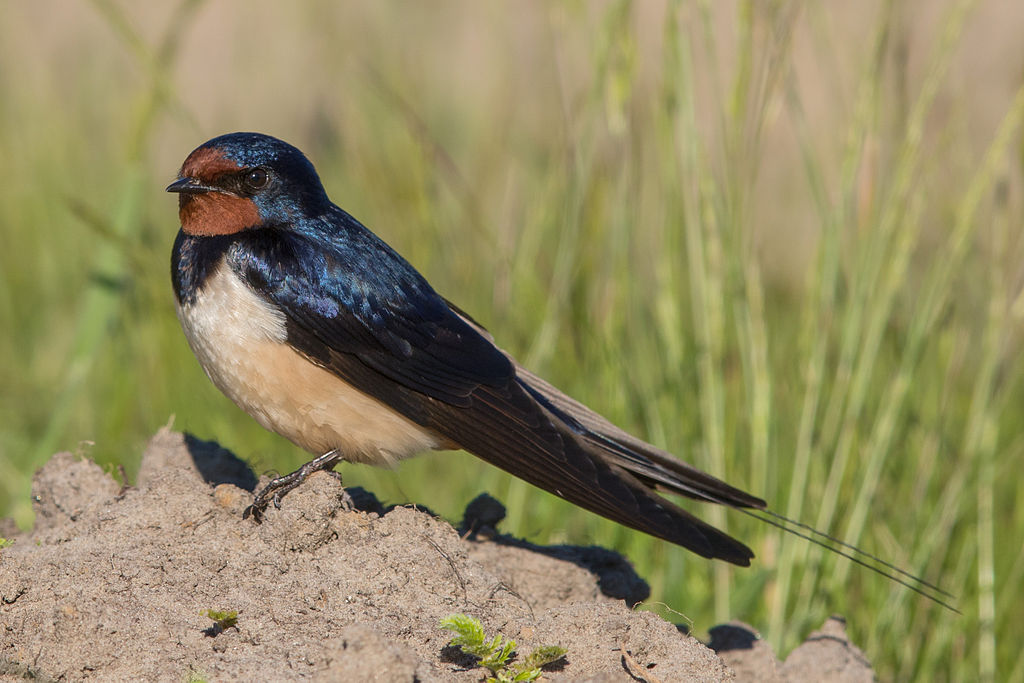
Coloration and Markings: Barn Swallows have deep blue backs and long, deep blue and sometimes grayish wigs. They have long, forked blue tails and when the bird is in flight you might even notice some white spots under this tail. The breast and underbelly of this bird are a warm orange color, with some white under the wings and a little over each shoulder, and you will also that the blue from the back comes as a line from each shoulder, going diagonally towards the center of the breast but stopping well short. It rather looks like the wings are ‘fastened’ to these lines. Facially, the bird is orange up until around cheek level with the exception of orange carrying up from the center to just above the bill, while the upper portion of the face is a deep blue. This bird has a black diamond-shaped mask and a short, sharp, straight black bill.
Size: These birds measure in at 5.9 – 7.5 inches in length with wingspans of 11.4 to 12.6 inches.
Habitat: Thee birds love open areas and you can see them in fields, parks, or even at the edge of the coast or ponds. They aren’t shy about human habitations and you might find them close to your work shed, nesting in bridges, or scoping out your backyard feeder.
Diet: On rare occasions you can catch them eating suet but more often berries are your best option. There is still a chance that this will not attract them, however, so hedge your bets with some crushed eggshells. Believed to aid the bird in digestion, Barn Swallows will sometimes consume eggshell pieces if you leave them out.
House Wren – Troglodytes aedon
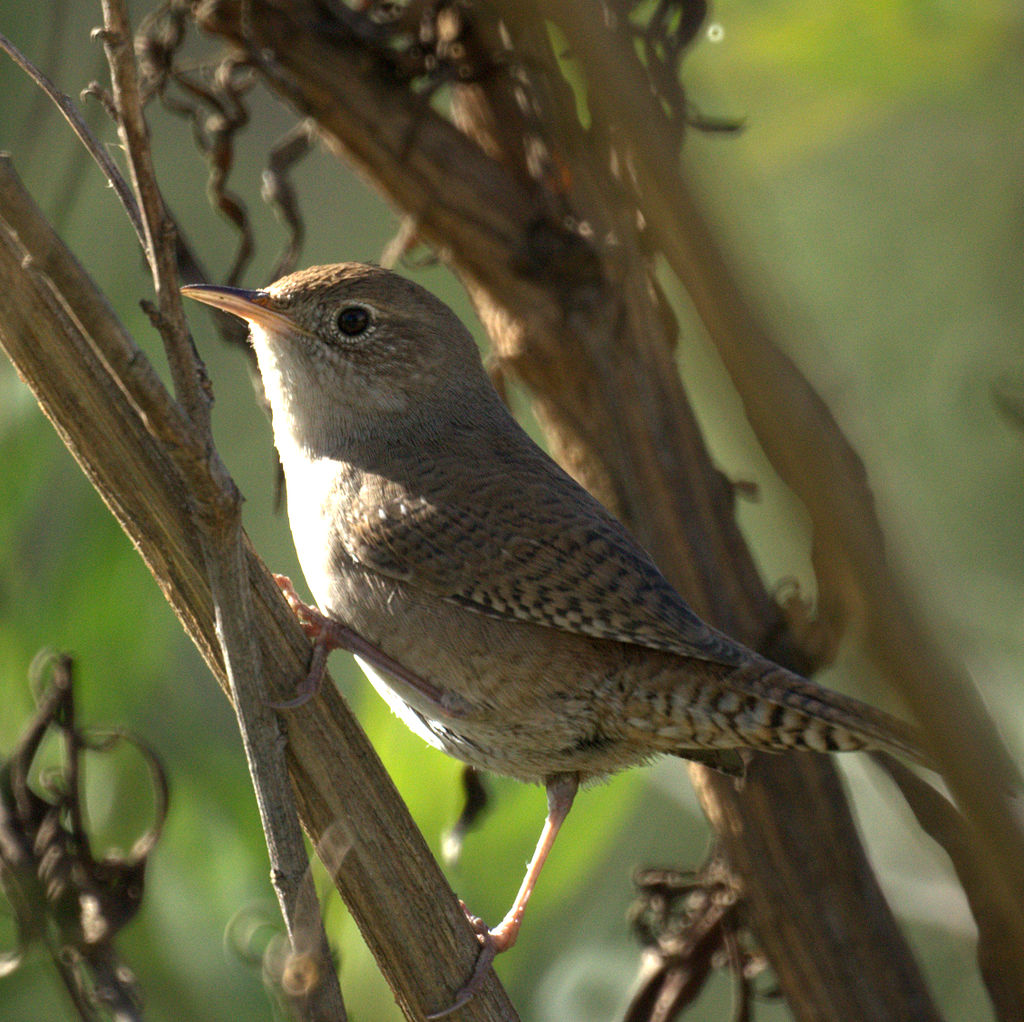
Coloration and Markings: House Wrens are small and often plump birds, with smooth brown back and shoulders and with brown and minor white barring from mid to the tip of the short wings. They have perky, medium-length tails and the breast and underbelly display a subdued version of the barring patterns you see on the wings, with denser color towards the underbelly and more white present on the breast. Facially, you may notice a white or whitish throat and speckles of white from the base of the throat to under the bill and across the cheek. Tiy white spots make a distinctive eyebrow line as well and this bird has a medium length, straight black bill with some minor curvature on the upper half of the bill.
Size: These diminutive Wrens measure in at 4.3 – 5.1 inches in length and have wingspans of approximately 5.9 inches from tip to tip.
Habitat: In the warmer months these birds are the most active, spending time in open areas such as the forest’s edge or local fields. At this time you are most likely to see them in your backyard and they also like to forage at farms. In the winter, they take to the brush and brambles but you might occasionally get a visit if you’ve stocked up your feeder in anticipation of their arrival.
Diet: Suet, broken-up peanuts, and hulled Black Oil Sunflower seeds are all favorites of the House Wren and may well tempt them into visiting your feeder.
Cedar Waxwing – Bombycilla cedrorum
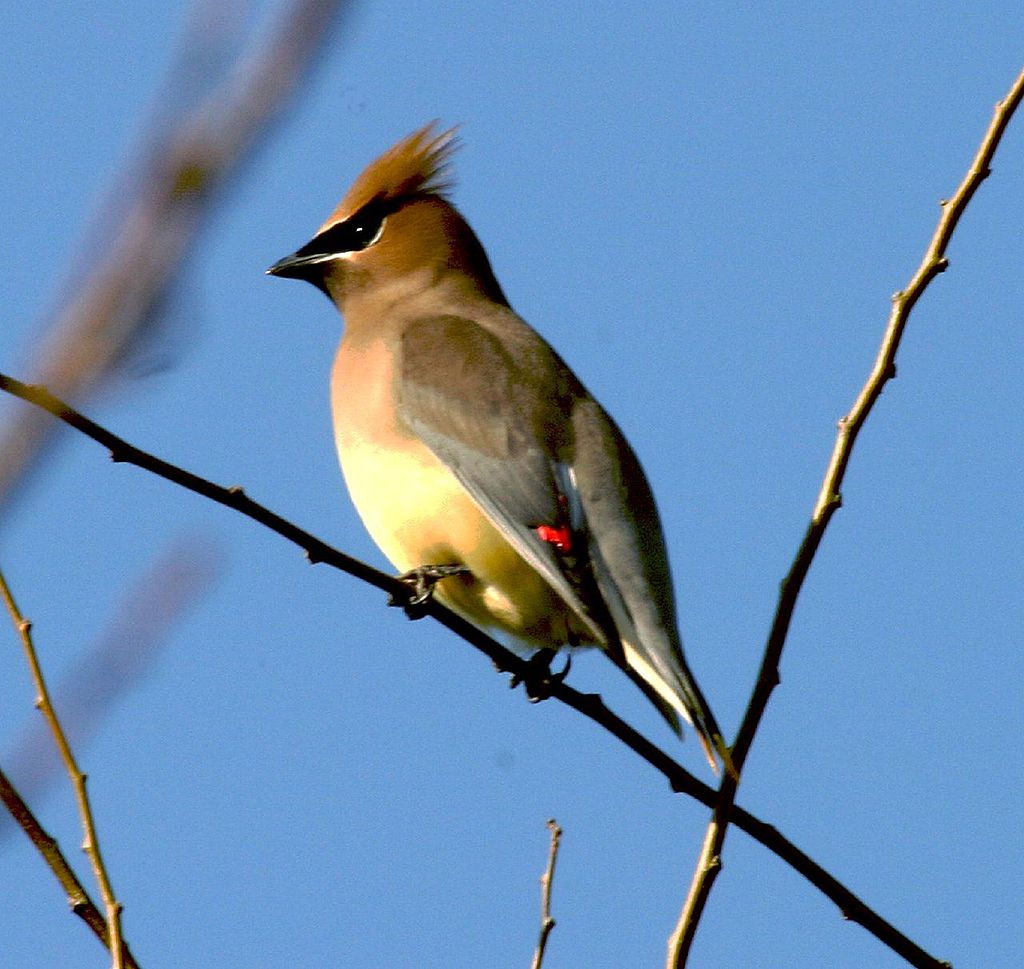
Coloration and Markings: Cedar Waxwings have quite the combination of colors. Their upper back and shoulder portions of the wings are a soft brown, which becomes a smooth gray as it moves down the back. The long wings are mostly gray going down, with the exception of blackening at the tips and a display of vertical waxy-red lines towards the center of the wing. The tails are short and yellow tipped, with a black layer above the yellow to separate the color from the remaining gray of the tail. The rump of this bird is white, while the breast and the underbelly are a mix of white and light yellow and a brown beard-like bib drapes majestically down the front and center of the breast. Facially, this bird is a velvety-soft brown with a black mask that passes the eyes and curves up to meet the end of the lovely brown crest of this bird. Small white lines accent the mask, showing above and below it, and this bird has a short, stout black bill which is straight, but displays a slight curve in the upper portion of the bill.
Size: These birds measure in at 5.5 – 6.7 inches in length and have wingspans of 8.7 to 11.8 inches.
Habitat: These birds love the woods but they also venture out to farms, parks, gardens, and orchards. They will happily visit a feeder provided that you’ve left out something which they like.
Diet: Cedar Waxwings primarily eat insects, however, they also have a sweet tooth that can be tempted with some fruits and berries. Try leaving out some orange halves and Blueberries and the results may be quite pleasing.
Scarlet Tanager – Piranga olivacea
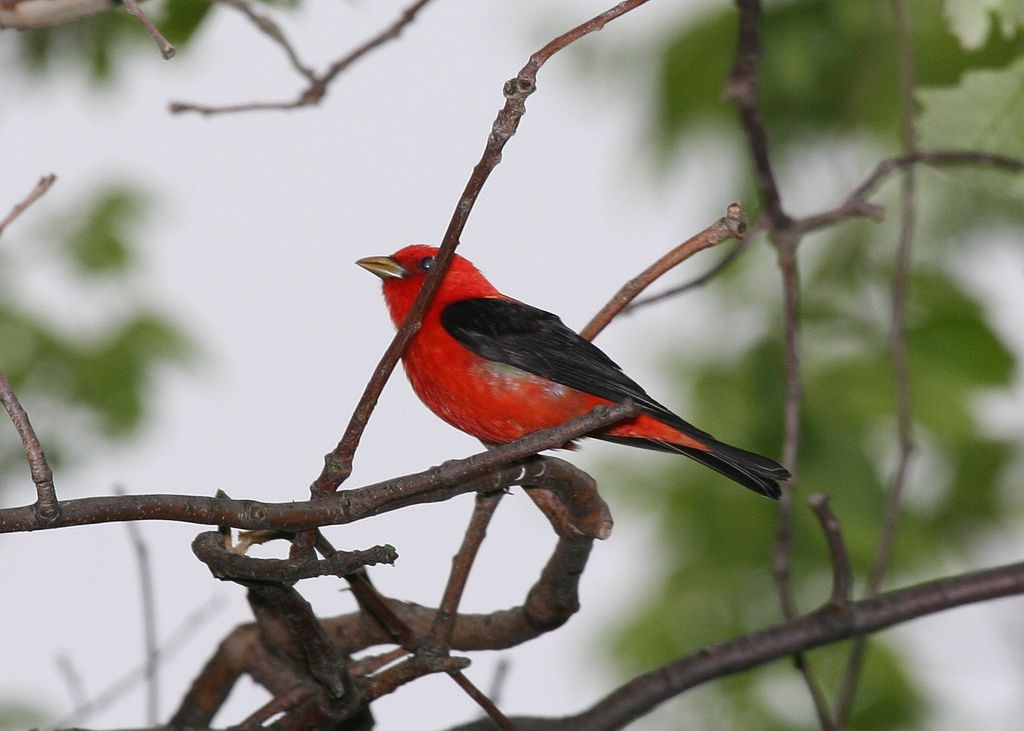
Coloration and Markings: Male Scarlet Tanagers are hard to miss, with lovely crimson coloration all over their bodies with the exceptions of their medium-length wings and short, forked tails, which will be dark black in color. Females and juveniles will actually be a yellowish-green, with olive wings instead of black ones and males shed their scarlet after mating season to go yellow-green as well, but the black remains in their wings and tails to facilitate identification. These birds have medium-length yellow or gray and yellow bills.
Size: These birds measure in at 6.3 – 6.7 inches in length and have wingspans of approximately 9.8 to 11.4 inches.
Habitat: These birds love deciduous and deciduous-Evergreen mixed woods, but they will venture into the occasional park or backyard from time to time.
Diet: These birds can be tempted with orange halves, grape jelly, or a good old standard such as Suet. Be a little patience as they are feeder shy but may well come to sample proffered fare.
Baltimore Oriole – Icterus galbula
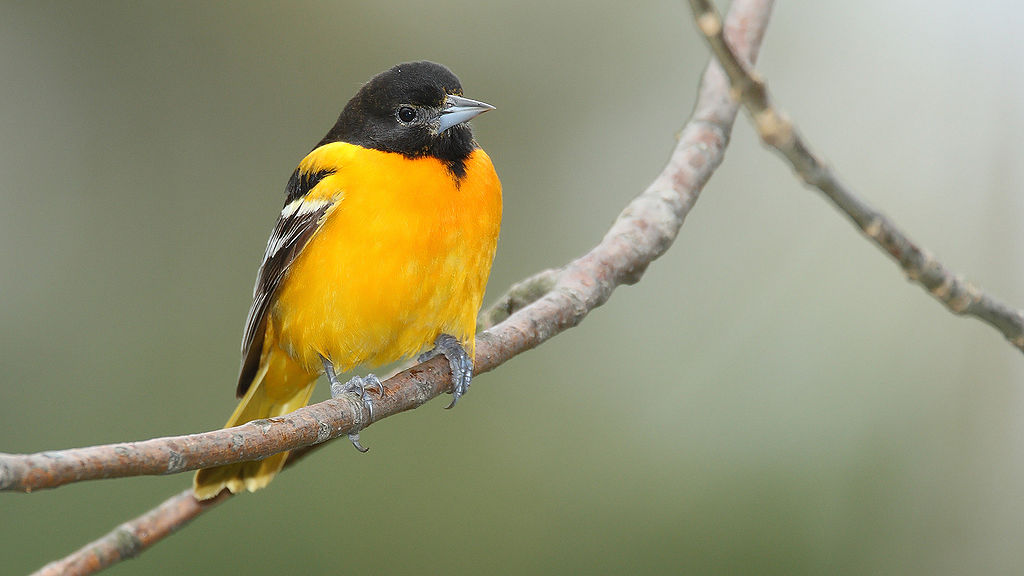
Coloration and Markings: Baltimore Orioles have quite the plumage! Male Orioles have black backs with a fiery-orange at their shoulder and long, black wings with a distinctive white bar along with white highlights in the wings. These birds also have black-topped tails which are yellow-orange at the edges and undersides, and the breast and underbelly of this bird are a brilliant firey-orange that reddens a it approaches the base of the throat. Facially, this bird is completely black with the exception of it’s medium-length, stocky silver bill. This bill has a slight curve to it which you will notice as well. Females and juveniles are colored a little less flamboyantly, with a grayish color on the head and back and with 2 very prominent wingbars presented.
Size: These birds measure in at 6.7 – 7.5 inches in length with wingspans of 9.1 to 11.8 inches.
Habitat: These birds love open woods, especially of the deciduous variety, so look for them around meadows, copses, orchards, and parks. They will happily visit a well-stocked backyard feeder as well, so be sure to leave out some treats to lure the Baltimore Oriole into your backyard. It’s a sight that will really make your day!
Diet: Suet, chopped apples, and Orange marmalade are all favorites of this bird. If you have to select only one, try the marmalade, as these birds simply love it!
New York ’s Fall and Winter Birds
The coldest winter in New York occurred in 1934, when temperatures reached 15 degrees below 0 on the Fahrenheit measurement scale, but typically you are looking at nights that can get as chilly cold as -2 degrees, with a daytime low of around 18 degrees. This is quite the sharp chill, to say the least, but the birds that we have listed below don’t mind it and will be out actively foraging during this time. Leave a little something out for these birds this winter because things are brutal out there:
- White-breasted Nuthatch
- Blue Jay
- House Sparrow
- Pileated Woodpecker
- American Tree Sparrow
White-breasted Nuthatch – Sitta carolinensis

Coloration and Markings: The White-breasted Nuthatch has a soft gray-blue back with medium length wings of the same color, which will have some black highlights and a very thin white wingbar on each wing. The have short, perky gray and black tils which are white on the undersides and the breast and underbelly of this bird are a snowy-white as well. If you look close there is also a distinct rust-red spot on the underbelly but it can be easy to miss if the bird is bouncing around. The white from the breast and belly carries up into the face where it takes up most of it, with the exception of a thin black line from the back of the eye that travels diagonally up and a thin, black cap which goes from the bill to the shoulders. This bird has a long, straight bill that is often black on top and whitish on the lower portion.
Size: These birds measure in at 5.1 – 5.5 inches from head to tail and have wingspans of 7.9 to 10.6 inches in width.
Habitat: These birds frequent the deep woods as well as the forest’s edge, preferring deciduous regions and with a fondness for trees such as Oak, Hickory, and Maple. Their second choice is coniferous woods and they will range out, especially in winter, to parks and backyards for a little foraging.
Diet: White-breasted Nuthatches are easy to please. Just stock up on shelled peanuts and suet and you are good to go!
Blue Jay – Cyanocitta cristata
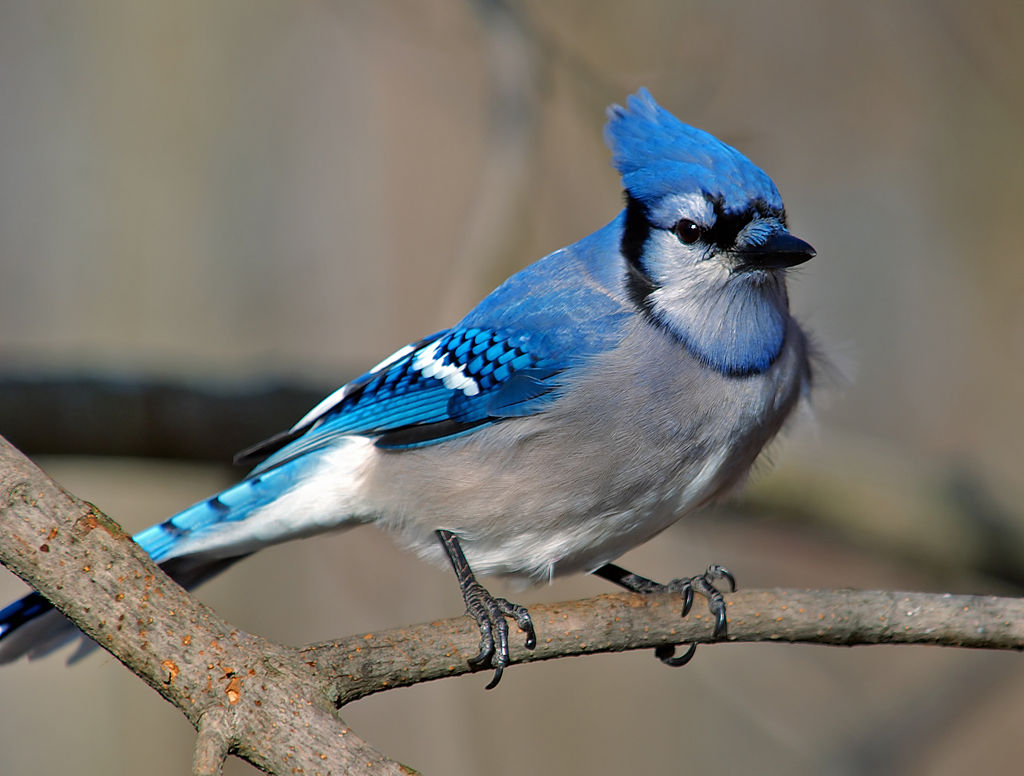
Coloration and Markings: Blue Jays are breathtaking birds. With light sapphire-blue backs and long wings bearing ‘scale’ patterns of blue outlined in black, as well as large white spots outlined in black towards the lower end, and a distinct wingbar on each wing. Their tails have a symmetrical pattern of light blue outlined in darker blue across their long, thin length, and have white on the undersides. The breast and underbelly of this bird are a brilliant paper-white, which carries up and is disturbed briefly with a black line which comes from the back of the tall, majestic blue crest atop the bird’s head. This line circles around the base of the throat to the other side and resumes a white coloration which takes up most of the Jay’s face. This bird also has a distinctive, somewhat chaotic thin black mask and it has a long, straight black bill.
Size: These birds are 0.8 – 11.8 inches in length and have wingspans of 13.4 to 16.9 inches.
Habitat: These birds love the forest’s edge, especially if there are Oak trees nearby with yummy acorns for them to smash. Blue Jays are not shy birds at all, however, when it comes to the city, and it is not uncommon to see them on phone lines or fences scoping out their potential next meals.
Diet: Peanuts, Black Oil Sunflower seeds, and suet cakes are 3 easy favorites that can attract and keep a Blue Jay’s attentions.
House Sparrow – Passer domesticus

Coloration and Markings: Male House Sparrows have back and wing coloration that is a mix of black and a foxy-red or tan. These wings are medium length, as are the tails, though the tail coloration often has a lighter color and a bit of gray is sometimes present. The breast and underbelly of this bird are a silvery gray mixed with white, which darkens as it approaches the underbelly and rump, and a concentration of black ill be seen on the upper breast as if dripping-down from the bird’s bib. The cheek area of the face is bright white and this carries from the edge of the bib across the base of the throat, and immediately above this is a a rich brown eyeline that passes the eyes and curved in to frame the cheeks. Above, typically from the forehead down, is a velvet gray at the top of the bird’s head and a small amount of black is present over the short, stocky black bill. You will notice a curvature present on the upper portion of the bill. Females, by contrast, tend to be a duller brown on top, though heavy streaking will be present, with a more drab gray at the breast and underbelly.
Size: These birds measure in at 5.9 – 6.7 inches in length and have wingspans of 7.5 to 9.8 inches in length.
Habitat: House Sparrows are quite suburbanized birds. Though they will visit the occasional farm, this is generally as close to the woods as they like to get, preferring instead the city sidewalks, phone lines, fences, and backyards where they can beg or forage a handout from us! These birds are quite willing to sing for their suppers, as it were, so leave a little something thoughtful out for them.
Diet: Shelled peanuts or chunky peanut butter mixed with suet are an easy way to tempt the House Sparrow into investigating and possibly frequenting your feeder.
Pileated Woodpecker – Dryocopus pileatus

Coloration and Markings: Savagely beautiful, Pileated Woodpeckers have black backs and long, black wings which have white on the undersides from the center to just before the black tips. This white forms a crescent shape that looks lovely when the bird is in flight or simply flexing those wings to show off. They have long, thin black tails which sometimes have a small amount of white on the undersides and a black breast with an underbelly which is black and peppered with white. The Woodpeckers have long necks which are black on the front and back but white on the sides and facially, they have white faces with a red stripe present from the bill to just short of the back of the head, as well as a black eyeline and a large red crest that is triangular and quite stunning. It almost looks like the bird has a big, red mohawk!
Size: These are bid ol’ Woodpeckers, measuring in at 15.8 – 19.3 inches from head to tail and with wingspans of 26 to 29.5 inches.
Habitat: These birds prefer mature forests of almost any type and often frequent areas with felled, dead trees, though they are not shy about ranging out into parks or backyards when they get a bit peckish (pun absolutely intended).
Diet: Pileated Woodpeckers love suet and will occasionally snack on peanuts if you’ve got them. Try a little crunchy peanut butter if you have a neighbor who has already put out some peanuts and it might just give you an edge when the bird is deciding where to eat.
American Tree Sparrow – Spizella arborea

Coloration and Markings: American Sparrows have brown and gray streaked backs and medium-length wings, with the wings displaying some minor black highlights towards the back and 2 distinct white wingbars also present on each wing. They have long, gray tails with soe white un the undersides from the rump and the breast and the underbelly of this bird are white as well with light buff flanking that is thickest at the breast. Facially, this bird has a gray face with a long, brown eyeline that curves slightly dow and a rust-red cap that looks lovely. These birds have short, straight bills that are typically yellow below and black on top. A smudged spot may be visible on the breast in the center but this is not always present.
Size: These birds average 5.5 inches from head to tail and have wingspans approximately 9.4 inches wide.
Habitat: These birds love dense cover, be it from weedy fields, bushes, brambles, or thorns. You can see them at the forest’s edge or in parks and backyards but plan accordingly. They like to show up in flocks so you should leave out a little extra in the feeder if can to accommodate them.
Diet: Cracked corn and suet can get the attention of the American Tree Sparrow and possibly earn you some repeat visits!
Supporting cast (Other Backyard Birds of New York that might pay you a visit)
To increase your list of year-round birds to see in New York you can look for our ‘supporting cast’ birds. While they don’t get the front page, these birds are celebrities in their own right and more than happy to visit a well-stocked feeder if you have left out a thoughtful offering. Watch for these ‘supporting cast’ birds throughout the year:
- Gray Catbird
- American Robin
- American Goldfinch
- European Starling
- Red-bellied Woodpecker
Gray Catbird – Dumetella carolinensis

Coloration and Markings: Gray Catbirds are almost entireley gray, with gray backs, medium-length wings, and long, gray tails, which are black on the undersides with a bright, vibrant foxy-red spot emanating from the rump. The breast and underbelly of this bird are a minutely softer gray and facially, the same gray is only broken by the thin, black cap and the bird’s long, straight black bill, which is slightly curved on the upper bill.
Size: These birds measure in at 8.3 – 9.4 inches in length with wingspans of 8.7 to 11.8 inches.
Habitat: These are birds of brush, brambles, thickets, and thorns. They love areas with cover, especially those close to water where the Gray Catbird can forage within the relative security that this vegetation provides.
Diet: Catbirds actually have some wacky tastes which they enjoy and you can really get great results with such non-standard fare as corn flakes, doughnuts, boiled or fried potatoes, and even cheese! Healthier alternatives include Black Oil Sunflower seeds, wheat, and oats, but if you have a Catbird that is frequently visiting you can have a little fun leaving out the occasional leftovers to see if they like them!
American Robin – Turdus migratorius
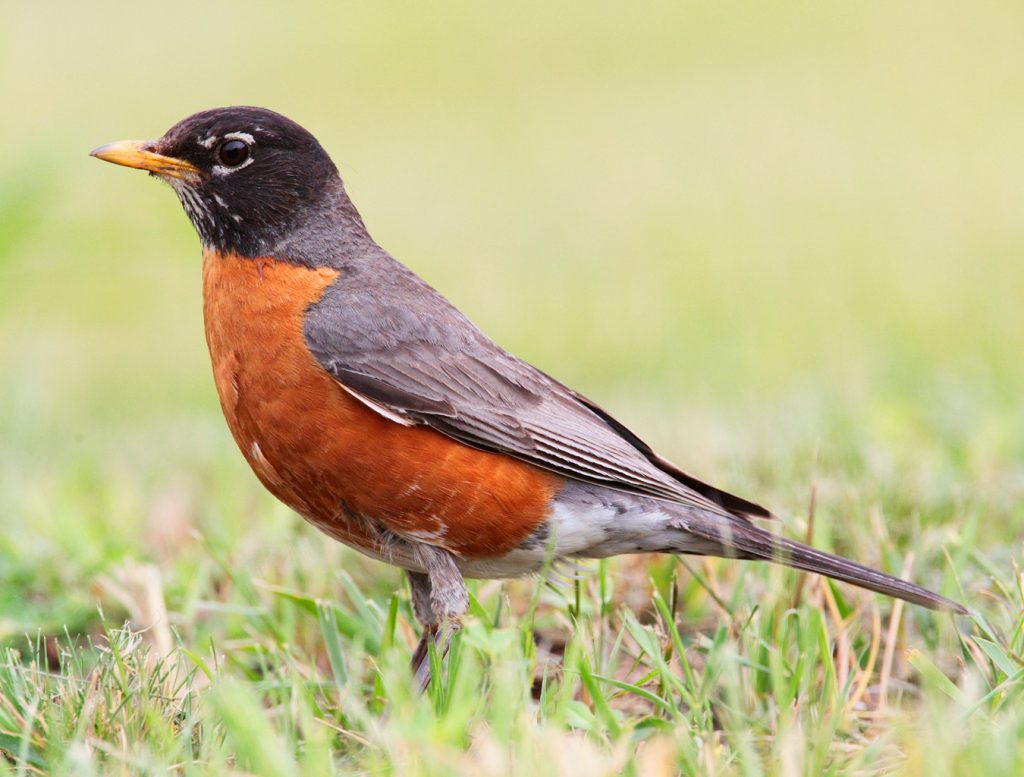
Coloration and Markings: American Robins have grayish-brown backs, with long grayish-brown wings and long, darker gray or brown tails which are white on the undersides. This white comes from the bird’s rump and the coloration then turns orange to orange red at the underbelly and breast all the way up to the base of the throat. Facially, this bird has a black face with a white eyering that looks fragmented yet distinct and this bird has a medium-length, slightly curved yellow bill. Females will have muted colors that tend to run together rather than the contrasting colors you see in the males.
Size: These birds measure in at 7.9 – 11 inches in length with wingspans of 12.2 to 15.8 inches.
Habitat: These birds are equally at home in the woods or the city, preferring deciduous woods when they are in Nature and golf courses, parks, orchards, and backyards when in the city.
Diet: These birds love Black Oil Sunflower seeds and suet and you can also give them a little treat with some grape or strawberry jelly.
American Goldfinch – Spinus tristis

Coloration and Markings: The American Goldfinch has a bright yellow back with long, black wings, which carry a number of white markings. Most dfistinctive are a white wingbar at and just below the shoulder on each with and some vertical white lines at the lower center. They have long, pointy black tails which are also heavily marked in white and white is also present on some of the undersides and it comes from the rump. Past the rump, the underbelly and breast of this bird are bright yellow like the back and this yellow carries on into the face. It is only broken by the presence of a jaunty black cap that starts at the middle of the head, crosses the forehead at a rakish angle and terminates at the stout, medium-length conical orange bill.
Size: These little birds measure in at 4.3 – 5.1 inches from tip to tail and have wingspans of 7.5 to 8.7 inches.
Habitat: These birds love overgrown fields and areas which are prone to flooding when they are not in the city. In the suburbs you can expect them just about anywhere but they prefer gardens and backyards with well-stocked feeders.
Diet: Mix some crunchy peanut butter with suet and you’ve got a potent lure to get the attentions of the American Goldfinch.
European Starling – Sturnus vulgaris
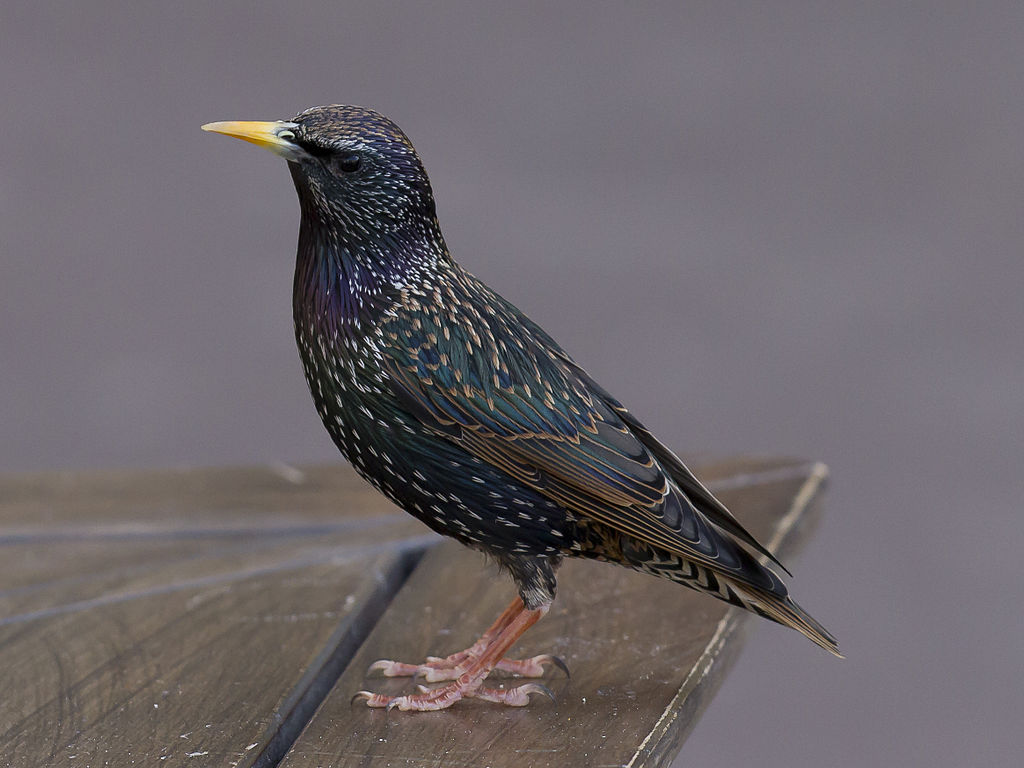
Coloration and Markings: European Starlings have a simple, beautiful coloration. They are completely a shiny mix of purple and greens that make the bird look black from a distance. They have short tails and long wings, and their bills are long, straight, and yellow. In the winter they change things up a bit, molting into brown plumage with white spots.
Size: Roughly Robin-sized, these birds measure in at 7.9 – 9.1 inches in length and have wingspans approximately 12.2 to 15.6 inches wide.
Habitat: These birds prefer to be close to humans and you are most likely to see them on phone lines, fences, or even strolling boldly down the sidewalks or your own front lawn.
Diet: European Starlings are easy to please, just stock up on suet cakes and that’s all you need. What and oats may be added for variety but they are more than happy with just the suet if that is all that you have handy.
Red-bellied Woodpecker – Melanerpes carolinus

Coloration and Markings: Red-bellied Woodpeckers have some amazing coloration. Their backs and long wings are black and white striped, reminiscent of a Zebra, and these stripes carry on to the tops and even the bottoms of their medium-sized tails. The rump is a mix of white with black spots but at the underbelly and breast this bird is largely white with splashes of faint red color on the breast and a distinct red spot on the underbelly. Facially, this bird is mostly white, with red splashes faintly visible at the cheeks and a rich red cap that goes down to shoulder-level. This bird has a long, straight black bill.
Size: These birds measure in at approximately 9.4 inches from head to tail and have wingspans of 13 to 16.5 inches.
Habitat: These Woodpeckers spend most of their time in the woods, preferring hardwoods and specific tree stands such as Hickory and Oak. They will visit backyard feeders and your chances of a visit are increased if you have some good, solid trees in your backyard to get this bird’s attentions.
Diet: Suet, Black Oil Sunflower seeds, and peanuts are all favorites of this bird and can earn you repeat visits to your feeder.
New York Bird Buffet
The New York Audubon has some great advice when it comes to setting up your bird feeder. We are including some example foods that we recommend as well, along with the Audubon’s advice, and we hope that between the two you can get one step closer to that ever-elusive ‘perfect feeder’ you are trying to make. Check out their article in our references if you would like more info from the Audubon and in the meantime, here are some things to include in your feeder for best results:
- Red and White millet
- Safflower seeds
- Black Oil Sunflower seeds
- Fruit jelly (grape and strawberry or you can get creative)
- Orange marmalade
- Striped Sunflower seeds
- Sugar water for Hummingbirds
New York Birding Hot Spots
The Chirparazzi have visited New York and have a number of places to recommend for when you want to get out of the house and spot some lovely birds in their natural habitats. Here are some hotspots located at the compass points and central New York where you can look and if none of these are close, just check the link that we’ll have further below for something a little closer to home.
- Northern hotspot – Edward’s Nature Trail
- Eastern hotspot – Corkscrew Rail Trail
- Southern hotspot – D & H Canal Towpath
- Western hotspot – Greater Jamestown Riverwalk
- Central hotspot – Auburn-Fleming Trail
Detailed descriptions of each location as well as information regarding visiting and what birds you can see at these locations may be found at: https://www.traillink.com/stateactivity/ny-birding-trails/
In Closing
Today we have discussed the birding scene in New York and as you can see, our fine feathered friends are present and just waiting to be spotted by the patient, prepared birder. Be sure to use some of our tips to load up your feeder and visit one or more of those hotspots when you get a chance. The Empire State is well-worth exploring and there are some fine, fine birds to see. Until next time, we wish you the best. Happy birding, New Yorkers!
